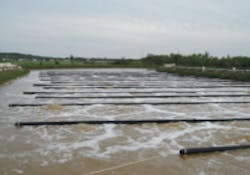Say Cheese
F&A Dairy, founded in 1958, began manufacturing cheese at its Dresser, Wis., facility in 1974. Five years after the plant’s opening, F&A constructed an aerated lagoon wastewater treatment plant (WWTP) with land irrigation, employing static-tube coarse bubble aeration. The system was originally designed to process approximately 3,000 lb per day biochemical oxygen demand (BOD). The system operated with satisfactory levels of dissolved oxygen for many years.
Problem
By April 2009, F&A had outgrown its WWTP. Due to significant increases in production, the static-tube aeration system was unable to deliver sufficient oxygen to the lagoon treatment system. The plant was processing close to 1 million lb of milk per day. The 35-year old system was not originally designed to handle such a large load and could not keep up with the plant’s needs.
The original static-tube aeration system was at capacity with all four 50-hp blowers (3,000 cfm each). Even at capacity, the system was only able to maintain a dissolved oxygen level of 0.1 mg/L, which resulted in operational troubles and odors.
For a short-term fix while F&A searched for a solution, the plant purchased an Ultra V 30-hp aspirating pump and rented two more. This added a 90-hp load onto the electricity consumption, in addition to the four 50-hp blowers powered by a portable diesel generator to handle peak summer conditions.
Solution
For a permanent solution, F&A hired Symbiont, a prominent consulting firm located in Milwaukee, to develop a long-term solution. Symbiont specializes in the design of industrial and municipal wastewater treatment facilities. It studied the plant wastewater and its existing treatment processes, in addition to viable aeration system technology. It also evaluated F&A’s other plant in Las Cruces, N.M., which already employed EDI’s Floating lateral system.
After the evaluation was complete, Symbiont recommended employing a fine-bubble aeration system that could be installed without dewatering the existing treatment lagoons and would provide an energy-efficient system to meet the demands of the 1 million lb per day production.
F&A purchased a fine bubble aeration system from EDI. The system employed floating HDPE air lateral assemblies with suspended tubular fine-bubble flexible membrane diffuser assemblies. It was installed in the summer of 2010, and it has reduced power consumption and has been able to handle peak loads, maintain dissolved oxygen and provide operating flexibility.
“[The plant has] been able to spray-irrigate their effluent because their nitrogen concentrations are lower than they have been in the past,” said Jonathan Butt of Symbiont. “That has saved the plant money because they are no longer paying the city to treat their effluent.”
